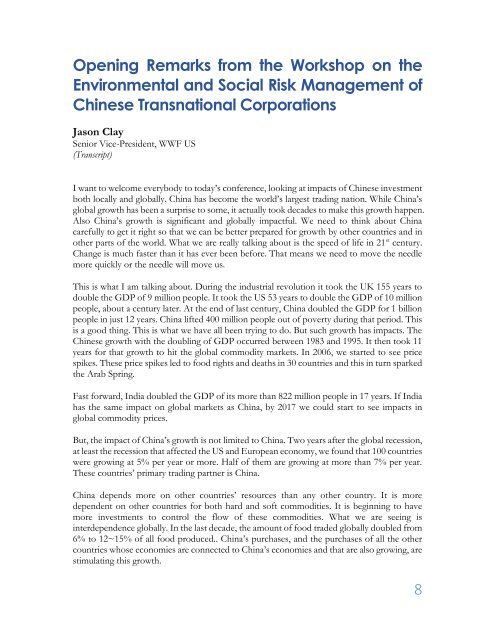Yale-WWF_final
Yale-WWF_final
Yale-WWF_final
You also want an ePaper? Increase the reach of your titles
YUMPU automatically turns print PDFs into web optimized ePapers that Google loves.
Opening Remarks from the Workshop on theEnvironmental and Social Risk Management ofChinese Transnational CorporationsJason ClaySenior Vice-President, <strong>WWF</strong> US(Transcript)I want to welcome everybody to today’s conference, looking at impacts of Chinese investmentboth locally and globally. China has become the world’s largest trading nation. While China’sglobal growth has been a surprise to some, it actually took decades to make this growth happen.Also China’s growth is significant and globally impactful. We need to think about Chinacarefully to get it right so that we can be better prepared for growth by other countries and inother parts of the world. What we are really talking about is the speed of life in 21 st century.Change is much faster than it has ever been before. That means we need to move the needlemore quickly or the needle will move us.This is what I am talking about. During the industrial revolution it took the UK 155 years todouble the GDP of 9 million people. It took the US 53 years to double the GDP of 10 millionpeople, about a century later. At the end of last century, China doubled the GDP for 1 billionpeople in just 12 years. China lifted 400 million people out of poverty during that period. Thisis a good thing. This is what we have all been trying to do. But such growth has impacts. TheChinese growth with the doubling of GDP occurred between 1983 and 1995. It then took 11years for that growth to hit the global commodity markets. In 2006, we started to see pricespikes. These price spikes led to food rights and deaths in 30 countries and this in turn sparkedthe Arab Spring.Fast forward, India doubled the GDP of its more than 822 million people in 17 years. If Indiahas the same impact on global markets as China, by 2017 we could start to see impacts inglobal commodity prices.But, the impact of China’s growth is not limited to China. Two years after the global recession,at least the recession that affected the US and European economy, we found that 100 countrieswere growing at 5% per year or more. Half of them are growing at more than 7% per year.These countries’ primary trading partner is China.China depends more on other countries’ resources than any other country. It is moredependent on other countries for both hard and soft commodities. It is beginning to havemore investments to control the flow of these commodities. What we are seeing isinterdependence globally. In the last decade, the amount of food traded globally doubled from6% to 12~15% of all food produced.. China’s purchases, and the purchases of all the othercountries whose economies are connected to China’s economies and that are also growing, arestimulating this growth.8


